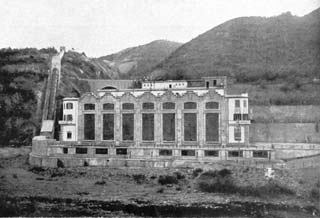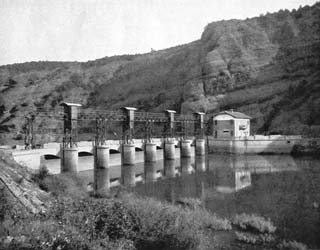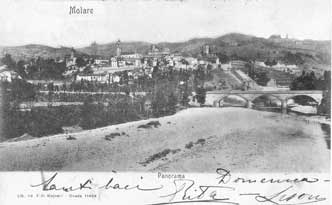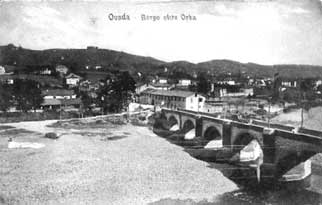


| The Disaster of Molare |
CHAPTER 3. August 13th : The Rainstorm
Daybreak on August 13 th , 1935 was clear and hot.
This year had to be kept in the memory as one of the driest period. Lack of water, further to the distress and damages caused to agriculture and farming, obliged the O.E.G., owner of the Ortiglieto reservoir, to make a plan for reducing drastically electrical production. The unavoidable consequence was the closure of the dam outlets, thus affecting badly the minimum flow of the quite dry Orba Torrent. At 6.30 a .m., the roaring of the thunder in the distance broke the monotony of the last months. The farmers turned their hopeful eyes southwards, to the mountains whereabove, very large, black clouds ran quickly northwards. At 7.30 a .m. a violent rainstorm fell down on Molare and Ovada. In Ortiglieto, rain had been falling since 6.00 a .m. Some comments upon the event got from “Eventi alluvionali e frane nel Bacino della Bormida, studio retrospettivo” by D. Tropeano: “364 mm . rain are falling in the Orba basin, in less than 8 hours.In the Lavagnina area the rainfall is 554 mm ( 182 in 2 hours), thus exceeding all similar events ... in Europe...since more than two centuries.”
Pluviometric data, recorded in all the district monitoring stations were really astonishing. In less than 8 hours, the event produced a rainfall nearly reaching the 30% of annual average fall in those areas. The river swelled quickly and, near the Ortiglieto lake, got a flow capacity of 2300 cubic meters/sec. Statistics show that in the Orba Valley, such a flood can happen every 1000 years about! But that day, statistics were of no use, and as well were useless the 855 cubic meters/sec. that the Main Dam was able to let flow away at full rating. During the first hours of the morning on August 13 th 1935, the outlet systems of the Main Dam were well closed, but soon the dam-keeper (Mr. Abele De Guz) realized that water level was increasing highly. The siphons along with the surface overflow were put in action, running at full rating.
At 10.30 a .m., the staff of the central power station and the dam-keeper put in operation the bell valve, which ran only for a few minutes and then was clogged by the mud , waste matters and detritus, filling more and more the lake bottom. Also the bottom outlet was of no use . Water started overflowing dangerously both dams, positioned at the same topographical level. The personnel of the central power station warned the colleagues in Ovada, informing them that “.....water flowing down was a lot....” At 11.00 a .m. the Orba torrent was overflowing its banks: the mill of Molare and the Ghiaie neighbourhood were under the threat of water as well as the lowest placed buildings of the Borgo of Ovada, many of which were going to be left.
Water level was 2 mt higher than both barrages. The dam-keeper did propitiatory gestures to take away the fear. In the meanwhile, at 13.00 p.m., Mr. Mario Grillo, (an engineer of the central power station in Ovada), who was already soaking, received a last frightening notice by the colleagues of the central power station in Molare urging “...to. warn the local Authorities and the Civil Engineers of Alessandria that danger was imminent”
Note a margine:
La traduzione del corpo di testo è stata curata dalla Sig.ra Vanda Martini che ringrazio moltissomo. Qualsiasi errore di traduzione presente nella pagina - es. didascalie immagini, barra dei comandi ecc - è attribuibile alla mia scarsa conoscenza dell'inglese
Map of the section:
- THE DISASTER OF MOLARE:
- The Beginning
- The Lake and the Secondary Dam
- August 13th : The Rainstorm
- The Huge Wave
- The Disaster of Molare
Sito curato da Vittorio Bonaria |





